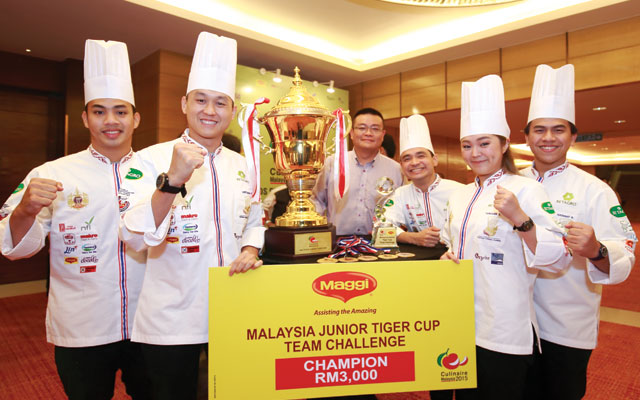Organisers of a new junior culinary competition employ creativity, technology and supplier support to keep ingredients fresh for contestants.
Event brief
The idea behind the Malaysia Junior Tiger Cup culinary team challenge was formulated by Kuala Lumpur Convention Centre’s executive chef, Richmond Lim, who desired a platform to develop the talent of aspiring young chefs.
It took a year for the centre and the Malaysian Association of Hotels to conceptualise and plan the Malaysia Junior Tiger Cup, before it was inaugurated at Culinaire Malaysia 2015, a culinary challenge held in conjunction with the 13th Malaysia International Exhibition of Food, Drinks, Hotel, Restaurant & Foodservice Equipment, Supplies, Services & Related Technology (commonly known as FHM 2015).

The Malaysia Junior Tiger Cup saw 12 teams of five young chefs and chefs-to-be create three modern cuisine dishes – an appetiser, a main course and a dessert item.
According to Lim, the inaugural competition attracted strong interest, with participants from Malaysia, Taiwan, South Korea, Indonesia, Hong Kong, the UAE, Thailand and Singapore.
Challenges
Like any culinary competition, sourcing for and providing fresh quality ingredients to the participants were of utmost importance. The organisers were particularly concerned about the storage of ingredients for the Mystery Box challenge. Additionally, due to the large number of participants, the centre expected a high wastage of ingredients.
Lim explained: “The Mystery Box challenge was the most unusual element of the event as teams had to catch live eels and cook them as part of their dish. We needed a plan to ensure the eels were safely stored and kept secret from the competitors.”
Another challenge for the organisers came in the form of the event layout, which unexpectedly proved to be an inconvenience for both the judges and the audience. The judges had difficulties moving around the event area while the audience were unable to get a direct view of the competition happenings.
Solutions
To ensure that the ingredients remained fresh for participants to use in their cooking, the centre worked closely with suppliers to select top quality produce and followed a delivery timeline. The centre also utilised its technologically-advanced kitchens to store the items.
Food wastage was minimised by using a cabinet trolley refrigerated container system that was invented for the competition. The system enabled ingredients not used during the competition to be stored and later recycled for other purposes, such as in the preparation of committee meals. The same system was also used in Culinaire Malaysia 2015, which resulted in a 60 per cent decrease in food waste collected in 2015 compared with Culinaire Malaysia 2013.
As for the eels in the Mystery Box challenge, they were placed in a tank equipped with an oxygen pump.
The layout problem was, unfortunately, without a solution. Lim commented: “This is an area which will need to be addressed at the next edition, perhaps by having a raised viewing platform for spectators or a ‘live’ feed projected onto big screens.”
Key takeaways
Emphasising on the importance of early preperations to minimise challenges and avoid setbacks during the event, Lim said: “To cope with the organisational and coordination challenges, groundwork started almost one year in advance. Of course, having an experienced team on the job helps!
In addition to the numerous teleconferences and meetings with the organisers, internally we had countless inter-departmental meetings to go over all the different aspects.”
Event: Malaysia Junior Tiger Cup 2015
Organisers: Kuala Lumpur Convention Centre and Malaysian Association of Hotels
Venue: Kuala Lumpur Convention Centre
Date: September 29 to October 2, 2015
Number of participants: 12 teams of five chefs





















